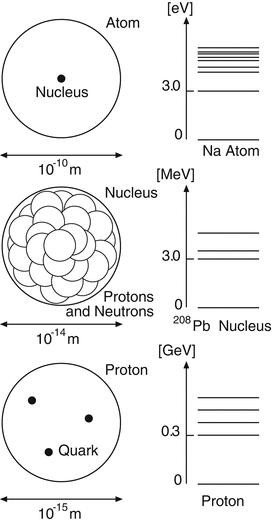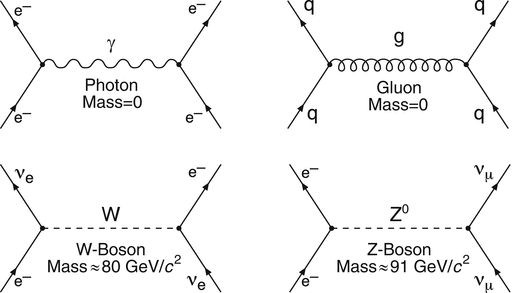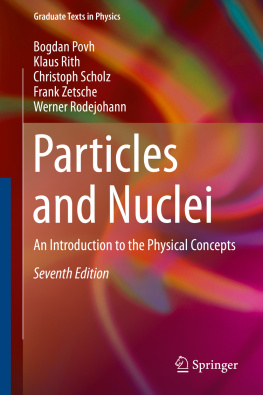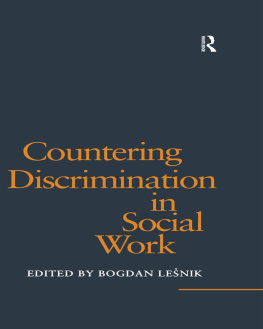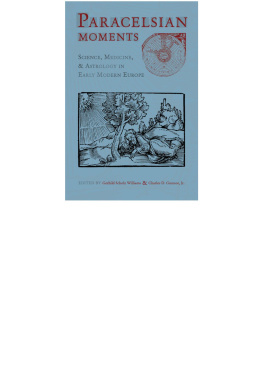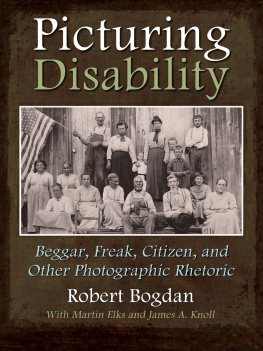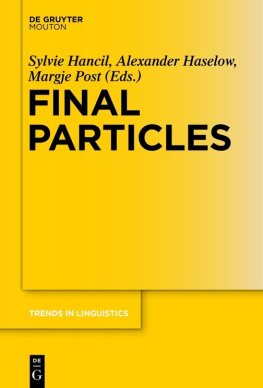1.1 Fundamental Constituents of Matter
In their search for the fundamental building blocks of matter, physicists have found smaller and smaller constituents which in their turn have proven to themselves be composite systems. By the end of the nineteenth century, it was known that all matter is composed of atoms. However, the existence of close to 100 elements showing periodically recurring properties was a clear indication that atoms themselves have an internal structure, and are not indivisible.
The modern concept of the atom emerged at the beginning of the twentieth century, in particular as a result of the experiments by Rutherford and co-workers. An atom is composed of a dense nucleus surrounded by an electron cloud. The nucleus itself can be decomposed into smaller particles. After the discovery of the neutron in 1932, there was no longer any doubt that the building blocks of nuclei are protons and neutrons (collectively called nucleons). The electron, neutron and proton were later joined by a fourth particle, the neutrino, which was postulated in 1930 in order to reconcile the description of -decay with the fundamental laws of conservation of energy, momentum and angular momentum.
Thus, by the mid-thirties, these four particles could describe all the then known phenomena of atomic and nuclear physics. Today, these particles are still considered to be the main constituents of matter. But this simple, closed picture turned out in fact to be incapable of describing other phenomena.
Experiments at particle accelerators in the 1950s and 1960s showed that protons and neutrons are merely representatives of a large family of particles now called hadrons . More than 200 hadrons, sometimes called the hadronic zoo, have thus far been detected. These hadrons, like atoms, can be classified in groups with similar properties. It was therefore assumed that they cannot be understood as fundamental constituents of matter. In the late 1960s, the quark model established order in the hadronic zoo. All known hadrons could be described as combinations of two or three quarks.
Figure shows different scales in the hierarchy of the structure of matter. As we probe the atom with increasing magnification, smaller and smaller structures become visible: the nucleus, the nucleons, and finally the quarks.
Fig. 1.1
Length scales and structural hierarchy in atomic structure. To the right, typical excitation energies and spectra are shown. Smaller bound systems possess larger excitation energies
Leptons and quarks
The two fundamental types of building blocks are the leptons , which include the electron and the neutrino, and the quarks . In scattering experiments, these were found to be smaller than 1018m. They are possibly point-like particles. For comparison, protons are as large as1015m. Leptons and quarks have spin 12, i.e., they are fermions. In contrast to atoms, nuclei and hadrons, no excited states of quarks or leptons have so far been observed. Thus, they appear to be elementary particles.
Today, however, we know of six leptons and six quarks as well as their antiparticles. These can be grouped into so-called generations or families, according to certain characteristics. Thus, the number of leptons and quarks is relatively large; furthermore, their properties recur in each generation. Some physicists believe these two facts are a hint that leptons and quarks are not elementary building blocks of matter. Only experiment will teach us the truth.
1.2 Fundamental Interactions
Together with our changing conception of elementary particles, our understanding of the basic forces of nature and so of the fundamental interactions between elementary particles has evolved. Around the year 1800, four forces were considered to be basic: gravitation, electricity, magnetism and the barely comprehended forces between atoms and molecules. By the end of the nineteenth century, electricity and magnetism were understood to be manifestations of the same force: electromagnetism . Later it was shown that atoms have a structure and are composed of a positively charged nucleus and an electron cloud; the whole held together by the electromagnetic interaction. Overall, atoms are electrically neutral. At short distances, however, the electric fields between atoms do not cancel out completely, and neighbouring atoms and molecules influence each other. The different kinds of chemical forces (e.g., the Van der Waals force) are thus expressions of the electromagnetic force.
When nuclear physics developed, two new short-ranged forces joined the ranks. These are the nuclear force , which acts between nucleons, and the weak force , which manifests itself in nuclear -decay. Today, we know that the nuclear force is not fundamental. In analogy to the forces acting between atoms being effects of the electromagnetic interaction, the nuclear force is a result of the strong force binding quarks to form protons and neutrons. These strong and weak forces lead to the corresponding fundamental interactions between the elementary particles.
Intermediate bosons
The four fundamental interactions on which all physical phenomena are based are gravitation, the electromagnetic interaction, the strong interaction and the weak interaction.
Gravitation is important for the existence of stars, galaxies, and planetary systems (and for our daily life), it is of no significance in subatomic physics, being far too weak to noticeably influence the interaction between elementary particles. We mention it only for completeness.
According to todays conceptions, interactions are mediated by the exchange of vector bosons, i.e., particles with spin 1. These are photons in electromagnetic interactions, gluons in strong interactions and the W+, W and Z0 bosons in weak interactions. The diagrams in Fig. show examples of interactions between two particles by the exchange of vector bosons: In our diagrams we depict leptons and quarks by straight lines, photons by wavy lines, gluons by spirals, and W and Z0 bosons by dashed lines.
Fig. 1.2
Diagrams for fundamental interactions between particles by the exchange of vector bosons
Each of these three interactions is associated with a charge: electric charge, weak charge and strong charge. The strong charge is also called colour charge or colour for short. A particle is subject to an interaction if and only if it carries the corresponding charge:
Leptons and quarks carry weak charge.
Quarks are electrically charged, so are some of the leptons (e.g., electrons).
